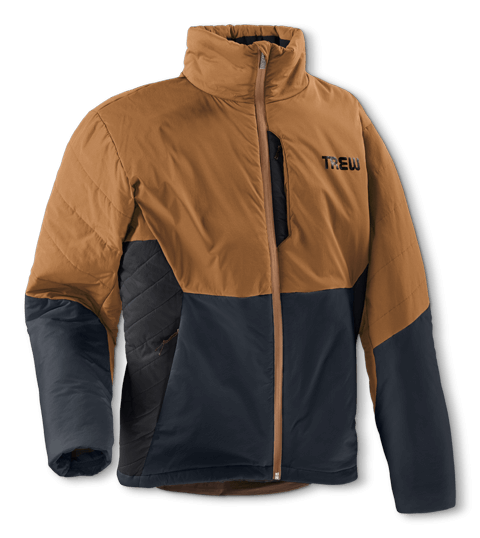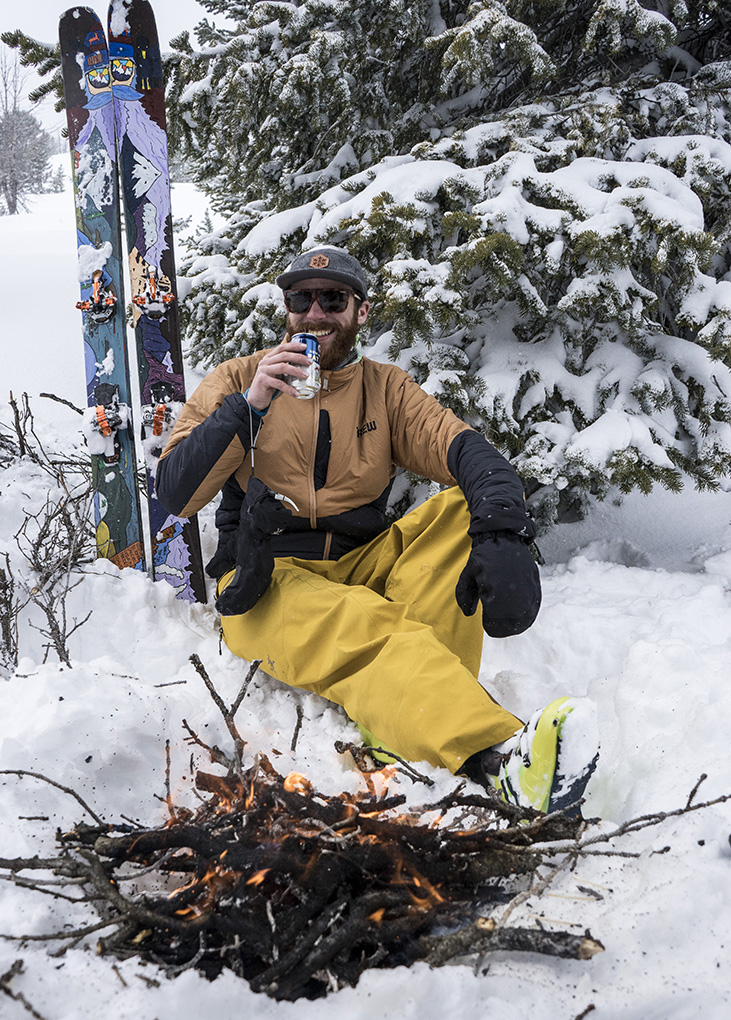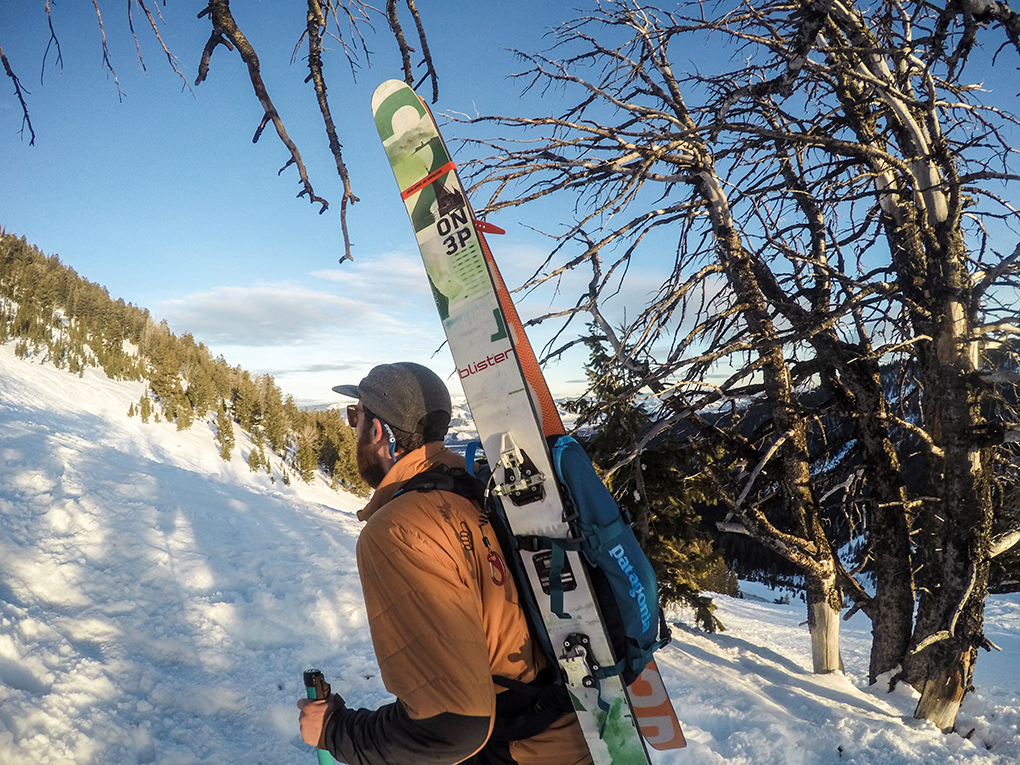
Trew Kooshin Jacket
Size Tested: Large
Materials / Construction:
- Shell Material: Stretch-woven ripstop shell fabric
- Lining: Stretch-woven inner lining
- Insulation: 3DeFX+ synthetic insulation
Stated Features:
- Strategic quilting keeps insulation in place
- High draft-cutting collar
- Hidden elastic cuffs
Pockets:
- Two zippered hand warmer pockets
- One zippered chest pocket
MSRP: $199
Reviewer: 6’, 185 lbs. Typically wears a size Large mid layer
Days Tested: 15
Test Locations: Driggs, Idaho; Teton Pass, Wyoming; Taos Ski Valley & Santa Fe backcountry, New Mexico
Intro
As we mentioned in our SIA coverage, non-puffy insulators are all the rage, with a multitude of companies introducing pieces with varying features and applications.
Trew’s foray into the field is the Kooshin Jacket, which they claim is: “so incredibly warm, comfortable and stretchy you’ll never want to take off, and it’s so breathable that you won’t have to.”
Since the Kooshin is positioned in a very similar space as the Patagonia Nano Air Jacket we’ve reviewed, I spent a week alternating between the two jackets while skiing and shooting in Taos, then skied in the Kooshin (both in and out of bounds) in the Tetons for two more weeks.
Fit
The Kooshin and Nano Air Jacket both fit very similarly, and well. At 6’0″ and about 185 lbs., I’m a size Large in just about everything, and the Kooshin was no exception.
The sleeves are long enough that I didn’t get any unwanted wrist exposure, and the hem drops low enough to keep out drafts, without sacrificing any casual style.

If you’re on the fence about sizing the Kooshin, or you’ve tried on a Nano Air, it’s a very good reference piece for sizing since they fit almost identically.
Performance
When the Kooshin arrived, I put it on, then I really didn’t take it off for the next 3 days. It’s stretchier than the puffies I’m used to wearing, and the shell material is much more robust while still allowing it to breathe well. I wore it casually around town and while traveling for a few days before we got to Taos, then dove into skiing and reviewing in earnest.
There I layered the Kooshin under the Knoble Standard jacket in conditions ranging from warmer days (~40° F) to cold (~5° F) and in knee-deep pow to sunny chop to some very windy skinning.
While I did overheat on a few warm ridge hikes, I was pretty much able to ignore it for the rest of the trip. It kept me warm without restricting motion, and made it easy to just ditch my shell and be ready for the casual apres scene.
The hand pockets are sized well and zip up securely, and the chest pocket is perfect for a phone or sunglasses.
I’ve been impressed by how well the Kooshin lived up to Trew’s claims. It’s comfortable enough that I never really wanted to take it off, but it breathes well enough to keep things from getting swampy in most situations.
Trew Kooshin vs. Patagonia Nano Air
The real question, though, is how the Kooshin stacks up against our much-adored and much-abused favorite, the Patagonia Nano Air.
First off, it’s important to note that the Nano Air comes in two flavors, the Hoody, and the Jacket (no hood). The Kooshin is only available in a non-hooded variant, so it’s much more comparable to the Nano Air jacket.
At $200 the Kooshin is $50 cheaper than the Nano Air Jacket, but is otherwise very comparable in features.
I swapped out between the Nano Air Jacket and the Kooshin when skiing Taos on a very cold, sunny week, and found the Kooshin to be a hair warmer and less breathable than the Nano Air.
And the Kooshin is significantly more wind-proof than the Nano Air, which is something I especially noticed on some blustery hikes. While wind cuts right through the Nano Air (it’s designed to), the Kooshin does a pretty decent job of protecting you from the elements. The Nano Air features a DWR coating, and while the Kooshin makes no claims on that front, so far, water does bead on the outside. We’ll see how that holds up after a few washes.

For me, the real moment of truth came as I packed to leave Taos. I’d already stuffed my Kooshin into my bag, and I was holding Jonathan’s Nano Air that I’d been A/B-ing over the past week. It would have been easy to stuff it into my bag, hope he didn’t notice for a while, and head back to the Tetons with the Nano Air instead.
But I wasn’t actually that tempted to make the swap. For my personal uses, the slight drop in breathability the Kooshin gives up to the Nano Air is negated by the Kooshin’s better wind proofing. That gives the Kooshin a slight edge in versatility when worn without a shell, which for my uses at least, tips the scales in its favor.
(For what it’s worth, Jonathan has the opposite take: he’ll opt for the better breathability of the Nano Air, and is willing to forego the better windproofness of the Kooshin, since if the wind is brutal / brutally cold, he’ll probably throw a hardshell over his midlayer when skiing inbounds or touring.)
The punchline? These are two good pieces, you mostly just need to figure out what your priorities are.
Bottom Line
The Trew Kooshin is a functional and pretty stylish piece of insulation. Its stretch and breathability separate it from traditional puffies, and while it does sacrifice a bit of breathability to the Patagonia Nano Air in favor of better wind-proofing, that’s a tradeoff I’ll gladly make.

Does the Kooshin jacket have hip cinching capabilities or is it elastic?Thanks,BT